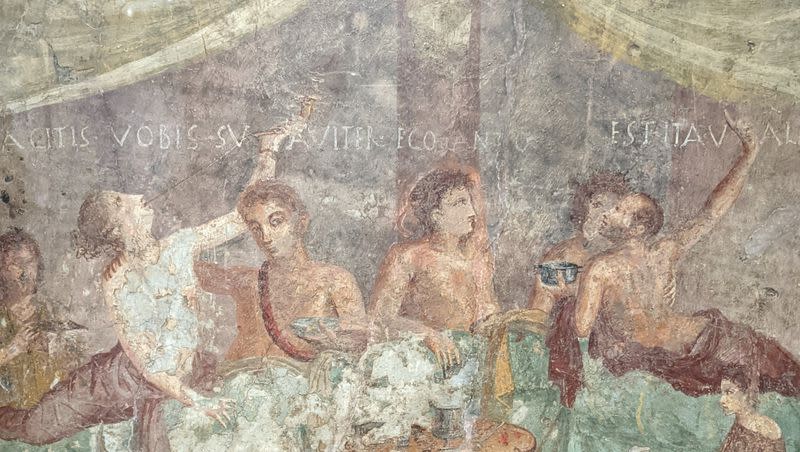Flatbread that looks like a pizza found on ancient fresco. What did the Romans eat?

- Oops!Something went wrong.Please try again later.
In the ancient city of Pompeii, archaeologists found a fresco near a bakery depicting a flatbread, which “might be the precursor to the Italian pizza,” the BBC reported.
While the flatbread doesn’t have the “classic ingredients” pizza has, archaeologists at the Unesco World Heritage park told BBC the flatbread “may have been eaten with fruits such as pomegranates or dates, or dressed with spices and a type of pesto sauce.”
Ancient Romans didn’t have access to tomatoes or mozzarella at the time. “Tomatoes were only introduced to Europe from the Americas a few centuries ago, and some histories have it that the discovery of mozzarella led directly to the invention of pizza in nearby Naples in the 1700s,” The Associated Press reported.
So while the fresco in Pompeii doesn’t depict a pizza, it does give insight into what ancient Romans ate. Here’s a deeper look at what a typical diet looked like for ancient Romans.
What did the ancient Romans eat?
Literature and cookbooks give insight into what the ancient Romans would have eaten. A cookbook attributed to Marcus Gavius Apicius called “De re conquinaria” or “On the matter of cooking” was compiled in the fifth century.
Authors like Horace and Petronius provided some insight into the diets of ancient Romans. Petronius wrote “Satyricon,” a work of fiction which included a section known as the Feast of Trimalchio. It satirized the way the upper class had banquets. Since it’s satire, it needs to be treated differently than a cookbook.
Cato the Elder, another Roman author, included recipes for porridge in his book on agriculture, according to the University of Pennsylvania.
One can also gain insight into how the Romans would have eaten by looking at ancient Roman laws, particularly grain laws. Grains like barley were important for the Roman diet across all economic classes and the way grain was distributed was a political matter in some ways, per Samuel Aly at Harding University.
A typical Roman diet was centered around grains, especially cereals, and legumes. Romans would eat vegetables or cheese on the side, and would include fish or honey or vinegar in their diet, per Smithsonian Institute. Meat was was eaten more commonly among those in the upper class.
Breakfast and lunch were similar meals in ancient Rome. Salted bread with dried fruit, cheese or eggs was a common breakfast meal and then for lunch, salted bread was also common and was sometimes accompanied by fruit, vegetables, fish or eggs, per Thought Co. Dinner could range from porridge to an elaborate meal with several courses including salad, oysters, cakes, cheeses, dates, meats and other food.
Bread was usually made with spelt, barley or wheat. Cheese and meat could accompany the bread, lentils, chicken or eggs. Porridge made from boiled grains with vegetables and herbs was also common among those who couldn’t afford bread, according to Getty. Romans would commonly drink wine mixed with water or honey.
A recent analysis from Austin Peay State University found that lower classes in Rome would eat a variety of different fishes and food like figs, eggs, olives and grapes.
Common fruits in ancient Rome were apples, olives, grapes, pears, peaches, plums, dates and figs. Common vegetables and legumes were beans, peas, lentils, asparagus, garlic, lettuce, leek, celery, artichokes, cabbage, turnip and others. Romans would eat meat like pork, geese, doves, quails, mutton, goat, deer, boar, poultry, flamingo, peacock, parrot or fish, according to World History.
Romans commonly used cumin, coriander and a type of fennel to season their food, per Britannica. They would also use a fermented fish sauce known as garum.
“A typical Pompeian tavern might have served grilled pork, chicken or goat with bread and vegetables” Paul Roberts, keeper of antiquities at Ashmolean Museum, said to The New York Times.

